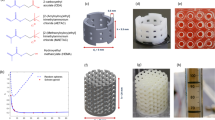Abstract
3D printing is lately utilized in biological sciences under the scope to develop customized scaffolds that will host biomolecules, either whole cells or parts of them, like enzymes. In the present work, we present a protocol to modify the surface of 3D printed polylactic acid (PLA) well-plates with the aim to co-immobilize multiple enzymes that will perform cascade reactions. Detailed steps to design and print the final models are described. The developed protocol for surface modification is based on coating with chitosan biopolymer and covalent immobilization of the enzymes β-glucosidase, glucose oxidase, and peroxidase via glutaraldehyde cross-linking. Enzymatic activity measurements indicative of the catalytic performance of the system are also presented.
Access this chapter
Tax calculation will be finalised at checkout
Purchases are for personal use only
Similar content being viewed by others
References
Ghilan A, Chiriac AP, Nita LE et al (2020) Trends in 3D printing processes for biomedical field: opportunities and challenges. J Polym Environ 28:1345–1367
Kong YL, Gupta MK, Johnson BN et al (2016) 3D printed bionic nanodevices. Nano Today 11:330–350
Lupuleasa D, Drăgănescu D, Hîncu L et al (2018) Biocompatible polymers for 3D printing. Farmacia 66:737–746
Baran EH, Yildirim Erbil H (2019) Surface modification of 3D printed PLA objects by fused deposition modeling: a review. Colloids Interfaces. 3(2):43
Maia-Pinto MOC, Brochado ACB, Teixeira BN et al (2021) Biomimetic mineralization on 3D printed PLA scaffolds: on the response of human primary osteoblasts spheroids and in vivo implantation. Polymers (Basel) 13:1–26
Ye J, Chu T, Chu J et al (2019) A versatile approach for enzyme immobilization using chemically modified 3D-printed scaffolds. ACS Sustain Chem Eng 7:18048–18054
Chen W, Nichols L, Brinkley F et al (2021) Alkali treatment facilitates functional nano-hydroxyapatite coating of 3D printed polylactic acid scaffolds. Mater Sci Eng C 120:111686
Schneider M, Fritzsche N, Puciul-Malinowska A et al (2020) Surface etching of 3D printed poly(lactic acid) with NaOH: a systematic approach. Polymers (Basel) 12:1711
Barbosa O, Ortiz C, Berenguer-Murcia Á et al (2014) Glutaraldehyde in bio-catalysts design: A useful crosslinker and a versatile tool in enzyme immobilization, https://pubs.rsc.org/en/content/articlehtml/2014/ra/c3ra45991h
Giannakopoulou A, Patila M, Spyrou K et al (2019) Development of a four-enzyme magnetic nanobiocatalyst for multi-step cascade reactions. Catalysts. 9:995
Yang Y, Zhang R, Zhou B et al (2017) High activity and convenient ratio control: DNA-directed coimmobilization of multiple enzymes on multifunctionalized magnetic nanoparticles. ACS Appl Mater Interfaces 9:37254–37263
Acknowledgments
This research has been co-financed by the European Regional Development Fund of the European Union and Greek national funds through the Operational Program Competitiveness, Entrepreneurship, and Innovation, under the call RESEARCH− CREATE−INNOVATE (project code: Τ2ΕDΚ- 01410). E.G. is thankful for the financial support to the Operational Program ≪Human Resources Development, Education and Lifelong Learning≫ in the context of the project “Strengthening Human Resources Research Potential via Doctorate Research” (MIS-5000432), implemented by the State Scholarships Foundation (ΙΚΥ), which is co-financed by Greece and the European Union (European Social Fund-ESF).
Author information
Authors and Affiliations
Corresponding authors
Editor information
Editors and Affiliations
Rights and permissions
Copyright information
© 2022 The Author(s), under exclusive license to Springer Science+Business Media, LLC, part of Springer Nature
About this protocol
Cite this protocol
Gkantzou, E., Skonta, A., Vasios, AG., Stamatis, H. (2022). 3D Printed Polylactic Acid Well-Plate for Multi-enzyme Immobilization. In: Stamatis, H. (eds) Multienzymatic Assemblies. Methods in Molecular Biology, vol 2487. Humana, New York, NY. https://doi.org/10.1007/978-1-0716-2269-8_10
Download citation
DOI: https://doi.org/10.1007/978-1-0716-2269-8_10
Published:
Publisher Name: Humana, New York, NY
Print ISBN: 978-1-0716-2268-1
Online ISBN: 978-1-0716-2269-8
eBook Packages: Springer Protocols




